
The World Health Organization at 75 - Fit for purpose!
By Carson Snyder '23
On Dec. 1, 2022, Lehigh continued its fall colloquium series with speaker Werner Obermeyer, director of the World Health Organization Office at the United Nations in New York. Obermeyer’s presentation titled “The World Health Organization at 75 – Fit for Health!” dove into the multitude of global programs that the WHO is currently addressing, specifically in women and girls.
Obermeyer was introduced by Eduardo Gomez, associate professor and director of the Institute for Health Policy and Politics. Gomez shared background on Obermeyer’s accolades in the health industry, which include a wide range of policy work done within the general assembly of the U.S. Congress, the WHO’s relations with the United Nations, and NGOs who focus on health progress. The WHO's role at the United Nations where Obermeyer works is to ensure that health is included in the political, socio-economic, and humanitarian discussions at the UN.
Obermeyer began his presentation by giving an overview of the WHO, which includes 194 member states, and spans 150 country offices and 800 different institutions supporting WHO’s work. The WHO boasts an approved budget of $6.1 billion for the 2022-2023 year, which will be used to achieve several goals set out by the UN.
These goals include providing universal health care, protection from health emergencies, and better health and well-being to one billion more people. Although significant progress has been made in these goals, the pandemic has set back the WHO from achieving the one billion mark for all three objectives.
Obermeyer also highlighted the current top causes of death, which include ischaemic heart disease, stroke, and chronic obstructive pulmonary disease (COPD). The common pattern, Obermeyer pointed out, is the occurrence of non-communicable diseases as a cause of death. These diseases account for 70% of all deaths, a rate that is expected to grow dramatically by 2030.
Nearly one billion people still spend more than 10% of their household income on health expenses, with almost 300 million people spending over a quarter of their household income on health, Obermeyer shared. Although service coverage has improved, COVID-19 has halted the progress made for disadvantaged populations in acquiring healthcare. Moreover, 92% of countries reported some extent of disruptions in necessary healthcare services following the pandemic. These services include primary care, emergency/operative care, elective surgeries, rehabilitation services, and community care.
Focusing on women’s health, Obermeyer explained that poverty yields a higher burden on women's and girls’ health, resulting in high rates of unexpected pregnancies, STDs, cervical cancer, and violence, among many other things. There are also major barriers to health education for women, as a handful of countries refuse to educate on reproductive health. The road to equal health outcomes for women has been burdened by discrimination based on ethnicity, class, and disability.
Obermeyer emphasized that a priority for women’s health should be elevating the position of women in the health and care workforce. Women comprise 70% of all healthcare workers, yet occupy only 25% of global health leadership roles and often face high gender pay gaps. To combat this, Obermeyer spoke on the UN’s Gender Equity Health and Care Workforce Initiative, which is a global program that promotes the inclusion of women in healthcare leadership positions, and equitable access for all women to PPE gear, COVID-19 vaccines, STD tests, etc.
Obermeyer also stressed the importance of quality sexual and reproductive health services. Although more women are utilizing modern contraceptives and STD testing, most countries do not have the resources to keep up with these demands. To meet these needs in most low-income countries, an investment of $9 per woman would be required annually. Although the WHO has helped in reducing maternal mortality by 35% in the last two decades, the pandemic has set back this progress immensely.
One topic Obermeyer felt particularly passionate to talk about was how to prevent and respond to violence against women. 25% of adolescent women will experience violence by an intimate partner by the time they reach their mid-twenties, Obermeyer said. This violence disproportionately impacts women in low and lower-middle-income countries and has been exacerbated by the pandemic as lockdowns disrupted vital support systems.
Obermeyer wrapped up his presentation by speaking about noncommunicable diseases among women. These diseases are responsible for 75% of women's deaths annually, with this burden expected to increase in the coming decades, especially in poorer countries. The WHO has launched programs like the Global Breast Cancer Initiative and the Global Strategy to Accelerate the Elimination of Cervical Cancer to combat these non-communicable diseases. Furthermore, mental health issues have been rising among women, with 500 million women reported as living with mental disorders and suicide.
Obermeyer’s presentation was followed up by a Q&A led by College of Health students Emma Closter and Jessica Berman, who both have experience working as UN Youth Representatives.

